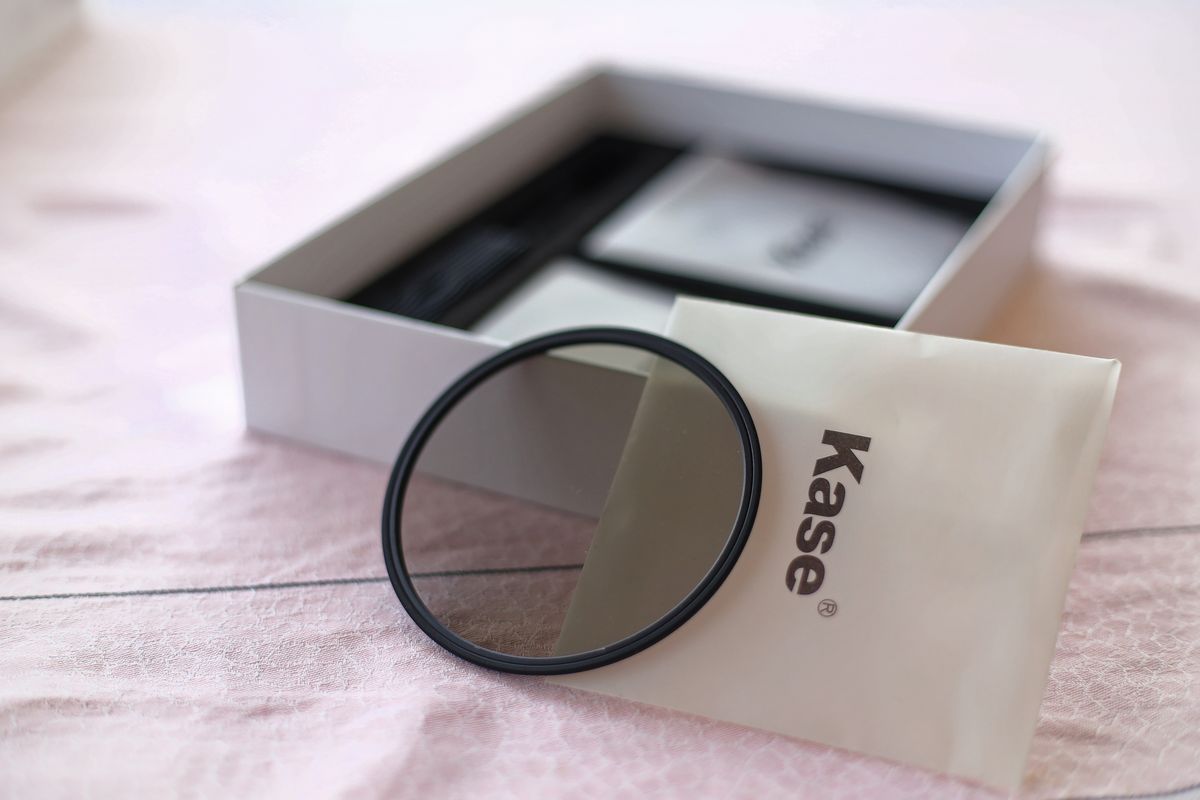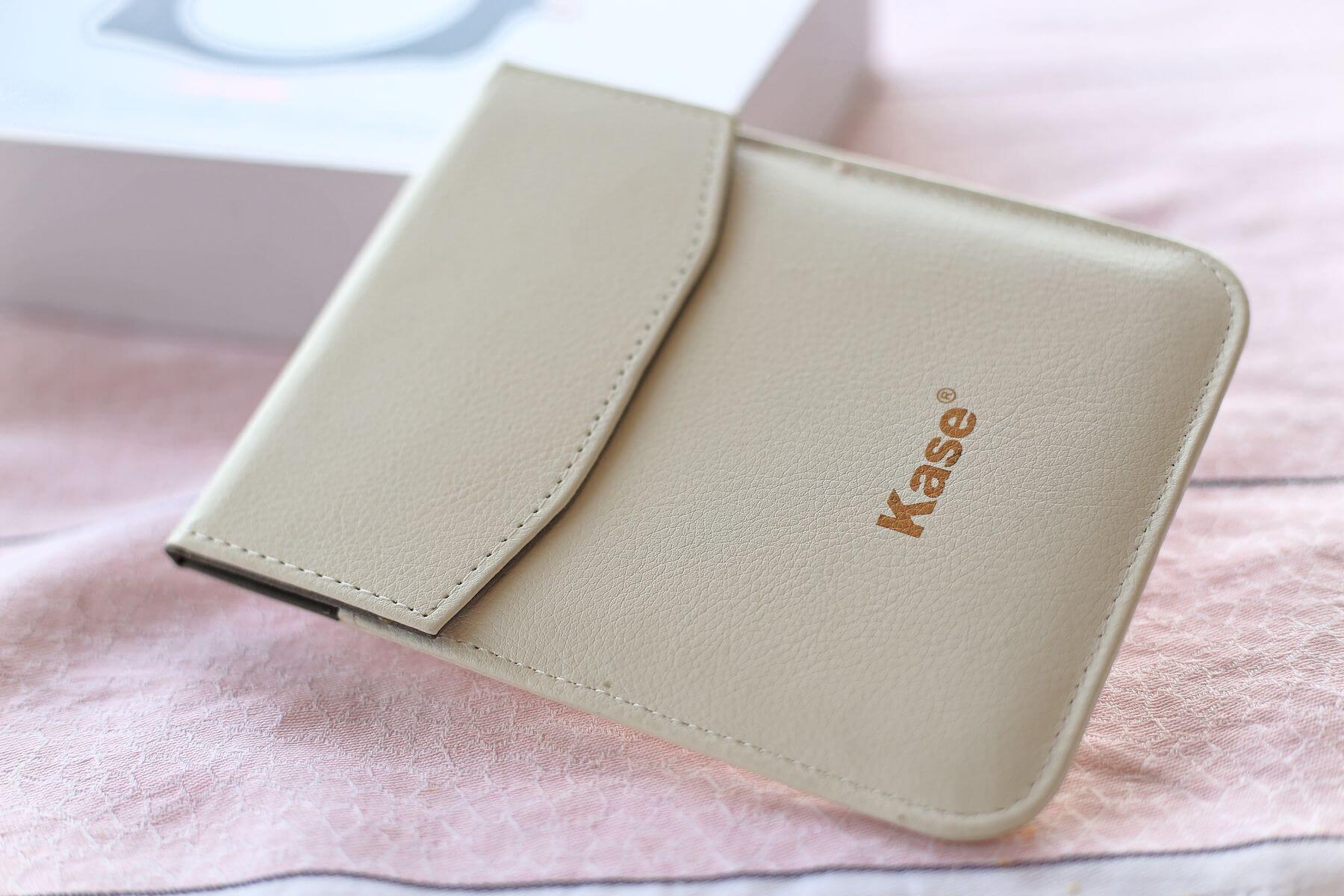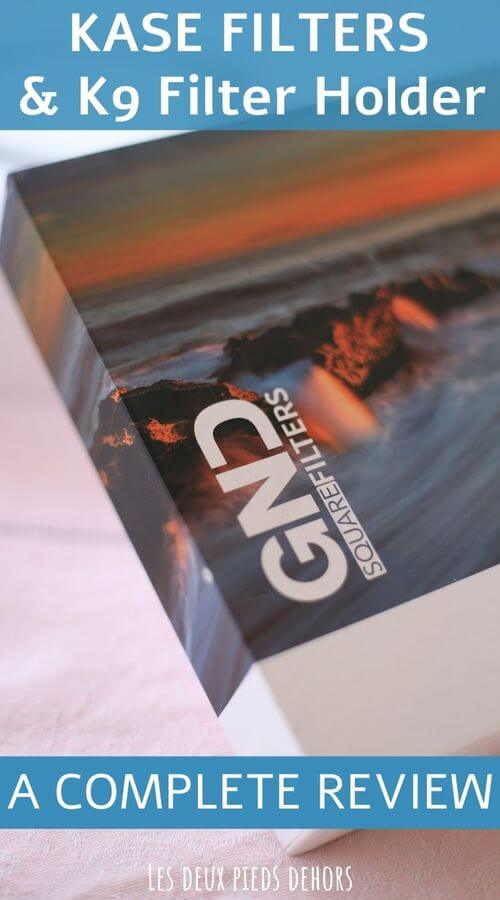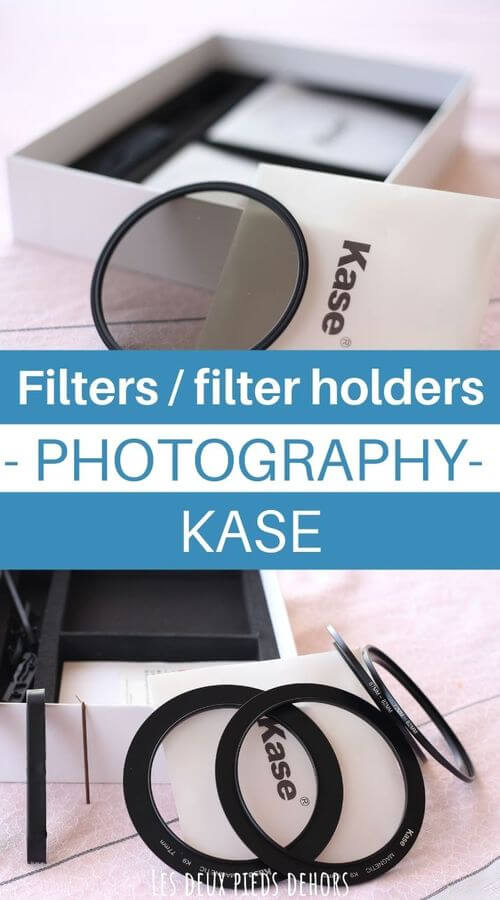KASE K9 filter holder review
Last update: 04/19/2024
Our blog continues to grow thanks to you, our readers. This blog may contain affiliate links, which means we can earn a small commission if you make a purchase through them, at no extra cost to you. This helps us to continue to bring you more and support our work!
Anyone following us on our blog should know that a large part of it is dedicated to photography, our second passion with Melanie. For more than three years now, we have been writing about photography and have been trying to help beginners in photography as much as possible, from the basics of photography, tips and advice, on how to progress in specific fields, choice of your camera equipment or the selection and use of your photo accessories.
And if there is one area I am particularly passionate about, it is accessories – especially camera lens filters. The link above gives you a preview of all the filters I consider really useful in photography: polarizing filters, ND (short for Neutral Density) filters or GND (Graduated Neutral Density) filters. I am one of those people who would much rather spend time shooting than behind a computer, trying to reproduce what I have seen in the field!
A few months ago, while I was writing a complete article on special filter holder systems for wide-angle lenses (which I need to update, by the way), I took the initiative to contact several brands of camera lens filter manufacturers in order to consider a partnership. The Chinese filter brand KASE replied favorably! I had in mind for quite a long time the idea to test camera equipment, and I’m happy that this first partnership is being set up, especially for camera lens filters!
It was thus with great pleasure that I was able to test a set of filters and filter holders from KASE. They have graciously sent me a package so I can give my opinion on the quality of their camera accessories. It will indeed be particularly interesting for me to test all of this because I’ve been using for several years the Lee system, which works well but is still cumbersome (and less handy now that I’ve seen what is done with other brands). As always on this blog, I mentioned at the beginning of this article that this is a partnership, and I remain entirely in control of my writings and my opinions on the subject.
I apologize for the time it took me to write this article, but between the expedition in France and then in French Polynesia, the two lockdowns of the Covid19, things were not that simple, and I can now take the time to catch up, during an excellent week spent in the Gambier Islands as a bonus, my French Polynesian paradise!
New Kase K9 filter holder and associated filters tested
I’ll present you below all the material I had the opportunity to test with, first of all, the content of the accessories sent by KASE, then the discovery of the K9 filter holder and of course, a field test of the filters sent and my associated opinions.
Camera equipment sent
Let’s just start there. What did I get to test from KASE? They were really nice to let me choose what I thought was interesting for me, so here is my choice:


In short, I had chosen this package because I think it contains the essentials I need for my use. I’ll have a lot of fun with it! Come on, let’s discover it!
The K9 KASE filter holder
Product Discovery
I’m more than happy to discover this superb protective hard box containing the K9 KASE filter holder and its accessories. I’m glad to see that the package is well packed, as it arrived without a scratch at the other end of the world. Everything is tidy and it clearly sets the professional look of the brand.
The filter holder K9 in the foreground of the box is the first thing you see. By lifting the top of the box, we discover then (in solid transparent pockets) a 90mm diameter CPL magnetic polarizing filter, two magnetic adapter rings (called “Magnetic Geared Adapter Rings”) in 77mm and 82mm (to fix the filter holder which will be magnetized on it), and step-up rings, simple adapter rings of 67-82mm and 72-82mm allowing to use this system with lower threads lenses. Worth noting that are also included in the package assembly tools (small screwdriver to remove the slots) on the filter holder, and two additional pairs of slots, allowing to use up to 3 filters stacked in front of the CPL filter.



View of the K9 100mm filter holder and its beautiful polarizing filter (top). Below, here are the contents of the package with, from left to right: the extra slots, an Allen key, the magnetic adapter rings in 77 and 82mm and the step-up rings 67-82mm and 72-82mm
So, let’s start with the base: the K9 100mm filter holder system. The advantage of this filter holder system (like the M50 from Haida and the S5 from NISI) is to be able to use a circular polarizing filter, independently of one or more other filters such as an ND or GND filter, which will be mounted here in front of the polarizing filter. The advantage of this system is especially to limit the size of the polarizing filter diameter (my 105mm Lee polarizer cost me a pretty penny) and to avoid light leakage behind the polarizing filter.
The filter holder looks really lightweight but strong at the same time. It is cut from an aluminum system (known for its aeronautical quality) and has a black anodized finished, designed to reduce reflections. The set looks like clearly being of good quality to me. The filter holder has an adjustment wheel allowing you to adjust its orientation. It is bright red, wide, notched and falls perfectly under the fingers. In comparison, the wheel on my Lee’s system is too small.
On the opposite side of the adjustment wheel, there is a toothed wheel that, once the magnetic polarizing filter is mounted on the filter holder, will allow to vary the degree of polarization of the image. I knew about this system because I had done quite a bit of research on different filter holder systems for the article mentioned in the introduction, but I never had the opportunity to test it by myself. I’ll tell you more about it below, but clearly, the system is well thought out and more practical than manually rotating a polarizing filter.



Detailed view of the elements of the filter holder: at the top, the side wheel on the side which is used to rotate the polarizing filter once mounted and the slot in the filter holder which makes it easier to catch the CPL filter – At the bottom, view of the large wheel on the other side, allowing the inclination of the filter holder to be varied (so it can be used at any angle)
Other interesting points to note, the filter holder is delivered with 2 slots mounted already allowing to place two filters (ND / GND) in front of the polarizing one. A black velvet is on the inside of the filter holder to minimize the entry of stray light, for example when placing an ND filter in the first slot for a long exposure. Last but not least, there are two notches in the filter holder allowing the magnetic PLC filter to be removed more easily.
By the way, the supplied 90mm circular polarizing filter appears to be of high quality as well. It is very thin (slim) and perfect to be used on the filter holder with wide-angle lenses. I’ll detail the operation below, but it fits very well on the filter holder.
Concerning the other accessories delivered, the magnetic adapter rings and the step-up rings are also strong and very light, in the same way the filter holder is. Concerning the magnetic rings (77mm and 82mm), they have an external thread that allows screwing on the front of the lens. Moreover, they also have an internal system consisting of a magnetic zone (for accommodating the polarizing filter) and a notch that, once mounted on the filter holder, will allow to vary the polarized effect of the colors thanks to the filter holder wheel. The step-up rings are basic, light, but do the job very well (I tried them on smaller diameter lenses).
In short, I have to say that I’m won over by the whole thing for now. Of course, I’ll see in use afterwards.
For those who are new here and are wondering why you should use a filter holder system rather than a circular filter one, here are the two main reasons:
- Firstly, many wide-angle lenses do not allow the use of conventional screw-on filters, because of a curved front lens and/or a fixed lens hood. It also depends of course on the size of your camera body’s sensor. This is especially true on wide-angle lenses mounted on full-format DSLRs. Because of their small size, manufacturers are increasingly able to release wide-angle lenses adapted to mirrorless camera that can accept screw-in filters,
- Finally, the filter holder system essentially allows the use of several stacked filters. For example, I use daily my CPL polarizing filter as well as a GND filter to attenuate the brightness on the clear part of the sky. For long exposures by the sea, I also often use an ND filter, a GND Reverse for the sky and sometimes a polarizing filter to see “through the water”. In short, without a filter holder, you are limited to only one filter, usually a polarizing or an ND one.
Installation and use in the field
I had the opportunity to test the “filter holder + polarizing filter” set for some time in several situations, including recently with a daily use during a week in the Gambier archipelago. Here is my feedback and everything you need to know about the mounting of this set as well as its use in the field.
The principle, simple in itself, is as follows:
1 – You must first screw the magnetic adapter ring on the front of your lens, using the external part of the ring which perfectly fits on the thread of the lens. For my tests, I used my Canon 16-35mm f/4 L IS which has a 77mm diameter. KASE provides in the package magnetic rings in 77mm and 82mm, common diameters on wide-angle lenses. If you have a wide-angle lens with a smaller diameter than 77mm, KASE also provides step-up rings (67-82mm and 72-82mm type). To put it simply, if you have a lens with a diameter between 67mm and 82mm, you can already start shooting. If you use a lens with a diameter smaller than 67mm (which will be rare in fact), you will just have to buy a step-up ring adapter with the right size for your diameter. By the way, I wrote a full article about adapter rings on this blog.
For example, I decided to mount the 67-82mm step-up ring on my Canon 70-300 L IS telephoto lens (67mm Ø), on which I then screwed the 82mm magnetic ring to mount my filter holder. Everything works perfectly and allows me to use my CPL filter + my GND/ND filters for my telephoto lens too (big advantage: no need to buy filters of different diameters).

2 – Once the ring is assembled on the front of your lens, you can place your filter holder on the magnetic ring. To do this, you will need to unscrew the red adjustment wheel (the largest one) to simply attach the filter holder to the ring. You have two arrows sign to show you how to place it. Once done, you have to screw it back on with the adjustment wheel. When using it, and if you shoot mainly with the same lens as I do, you can unscrew the set together at once (if you need to store it in your bag for example). Indeed, by tightening strongly the filter holder and the magnetic ring, you can remove the set directly from the front of the lens and screw it back on, if needed. This saves you from having to do two manipulations.

3 – Third step, you can now attach the magnetic CPL polarizing filter to the adapter ring you see inside the filter holder. Here, nothing very complicated: you will just have to bring the CPL filter close to the ring (the writings on the filter must be towards the ring) and you will feel the ring magnetizing towards the polarizing filter. Make sure the filter is well placed in the center of the set.
You are now ready to use it. You can already simply use the red wheel on the side. As you turn it, you will see that the wheel will grip the CPL filter’s knurling and make the filter rotate. Now you just have to choose the desired degree of polarization for your photo.
4 – The last step is simply to place the desired filter(s) in the slots of the filter holder. I did quite a few tests with the GND Soft Edge 1.2 from KASE which works perfectly to balance the exposure on a picture, when the light on the sky is very hard (as it is often the case here in the tropics). I often only keep one slot, but you can decide to place up to 3, so you can stack 3 filters. Just between us, I don’t think this has any real interest in the field. At the most, I often use a CPL filter on which I add an ND filter (to lower the exposure time for a long exposure for example) and a GND filter (to reduce the brightness on the sky). These filters fit very well in the filter holder’s slots, even if I would have liked a bit more rigid slots.

It may sound complicated when explained this way, but once you get used to it, it takes literally less than 15 seconds to set up. In short, for the use I’ve made of it during this week, which was of several hours a day, I’m really happy with the whole system. Very easy, practical to use, and the system of the wheel to vary the polarization is life changing.
Polarizing filters, ND and GND
KASE agreed to send me an ND64 filter as well as 3 GND filters (Reverse, Hard and Soft) so that I can test the whole. All the filters come in a white hard pouch to ensure 100% protection. Clearly, it is not unnecessary and it does inspire quality.
I was able to test the filters during small downpours and I really had no problem with it. The (glass) filters are completely water-repellent, and you only need to wipe off the raindrops with a little bit of cloth, without this leaving any traces of dirt on the filter. The coating is really great.




For those who do not know yet the utility of these filters and how to choose them, you should read these three articles:
- What is the purpose of a polarizing filter?
- What is the utility of an ND filter?
- Usefulness and choice of GND filters
I have decided not to provide a precise test of each filter individually in this article as it would finally be of little interest. I had the opportunity to test all of them, but more particularly the magnetic CPL filter, the GND Soft Edge 1.2 / GND Hard Edge 0.6 filter and the ND64 filter. However, I would like to give you my general observations on the filters’ quality.
Overall, the quality of the filters is truly very good. I did not notice any loss of quality with the use of the KASE filters. Regarding the 90mm CPL polarizing filter, I used it on about 500 photos and the result was really good. Colors and contrasts are really well improved, and the results are superb. In comparison, the color rendering appears a bit colder than with my Lee’s, but this is simply due to the “Landscape” treatment of the Lee filter which naturally warms up the colors of the photo when shooting.
Here are some examples of pictures shot on a tripod (to keep exactly the same composition), with and without polarizing filter. The difference on Polynesian lagoons is superb. Regarding the GND Soft 1.2 filter, it is rather simple to use and allows, thanks to the gradient on the upper part of the filter, to measure yourself the level of darkness you want to place on the sky as soon as you shoot. The result is good, and the camera really recovers substance in the sky thanks to the well-placed filter. Contrast and saturation of the sky are much better, and general appearance of the image is more homogeneous. It can sometimes be subtle when the difference of light between the different parts of the scene is not big, but when it is, the difference is huge. Here are two examples below of pictures without PLC and GND Soft Filter / With PLC and GND Soft Filter.


As you can see on the two pictures above, shooting with a polarizing filter really changes the game, especially on lagoons. The difference is real and, even if the clouds have moved between the two shots, you can see the difference in color saturation and increased contrast of the photo. Greens and blues are really more colorful, and you really bring out the turquoise color of the lagoon. Also note the substance on the clouds and in the sky that stands out thanks to the additional use of a GND Soft filter on the sky in this photo.


This is another example on a pontoon boat. Of course, the pontoon has moved slightly between the two shots, but we can clearly see the difference between the two pictures. You can also notice the substance recovered on the top left corner of the image when shooting with the Soft filter.
Regarding my daily use here, mainly on seascapes, I mostly use the GND Soft 1.2 filter. The GND Hard Edge 0.6 filter is more complicated to use as it requires special conditions, with a really pronounced difference between the foreground (darker) and a really clear sky (this is often found at the end of the day, for example). Of course, this implies to have a landscape in front of you with a perfectly uniform horizon line without elements disturbing the reading, typically a seascape. I had to go over it a few times to find the ideal conditions, but I finally succeeded one day in the late afternoon, while we were doing a small family photo shoot in the garden of Vaipahi, here on the island of Tahiti. I managed a few shots that really speak with and without filter, all on a tripod. Just look at the difference and the substance I managed to recover in the sky with the filter.


This late afternoon, the light on the sky was really hard and the spot was nice so I could try. On the picture above, I also have the CPL filter set up. As you can see, using a GND Hard Edge 0.6 filter is really useful in this situation. The black part of the filter perfectly filters the incoming bright light, and the camera sensor manages to correctly expose the scene. Without the filter, it would be almost impossible in fact. By focusing on the (darker) sea, the sky is totally overexposed without the filter. If I focus on the sky (clear), the whole foreground (the sea) is really underexposed. In short, the Hard GND filter is perfect for me. I didn’t notice any change in sharpness on the picture, even when zoomed to 100% in Lightroom or DXO. Note that I processed both photos with exactly the same treatment in DXO in order to get an equal comparison.
Finally, a few words about Neutral Density filters – also known as ND filters. I had the opportunity to do some tests of the ND64, which I normally use at the seaside or riverside, especially at sunset/sunrise. This allows me to get exposure times I consider suitable for a nice look.
Here again, I had to do some tests to find the right spot. I realized that if I really wanted to see the difference with and without the ND filter, especially regarding the quality and the impact of the filter on the picture, I couldn’t really shoot the sea for example, because placing the ND64 filter on a seascape would blur the sea and get that milky effect many people are looking for. So, I finally tried it on fixed subjects.


After a few pictures, I can say that I’m quite happy with this filter and the results obtained. I didn’t do extensive testing, but from the pictures I was able to take with and without the filter, there is little (or no) change in white balance with the ND filter and no change in image sharpness. Just compare the two images above, from a 100% export of an unprocessed RAW, to which I only added sharpness for export. The result with and without filter is identical. There is admittedly a slight difference between the two pictures, but it’s certainly due to my tripod having moved between the two shots (or my 5-year-old boy touching it, eh!).
In short, I can say that I’m really happy with this ND filter and its rendering, perfect for me too. If you shoot in RAW anyway (which I recommend), you’ll be able to adjust the final picture if necessary.
There is still the Reverse 1.2 filter that I need to test. I’ll try to do it soon when the opportunity arises, and I’ll come and update the end of this article!
I’m coming to the end of this first camera equipment test of the KASE filters and filter holder. I must say that I am truly very happy with the result, the tested material and the new filter holder system with the wheel to ajust the polarizing filter. To the point where I left aside my Lee system for now, which is likely to gather dust…
In any case, I can only recommend these filters and filter holder. The whole, although lightweight, appears very solid. Now it remains to be seen with time and daily use, but I think it should age well. Feel free to have a look at their website and see the range of filters and filter holders available. They really offer a very large choice, for mirrorless, compact and DSLR cameras, all in different sizes to fit GND, ND and CPL filters.
I’ll see you soon for a new camera test. If you are a big user of filters, please tell me which system do you use? I hope I’ll have the opportunity to test other brands of filters and filter holders in order to give you another feedback. In the meantime, don’t hesitate to read the other articles on the blog about photo accessories.
See you soon,

Written by Sylvain PONS
I've been passionate about photography since 2010, learning as I went along. Today, I dedicate myself to guiding others in their choice of camera gear and sharing a variety of tips to improve their photography skills.
Despite our care, a mistake may have slipped into this article. If you find any, please don't hesitate to let us know so we can correct it as soon as possible and keep our information up-to-date!










